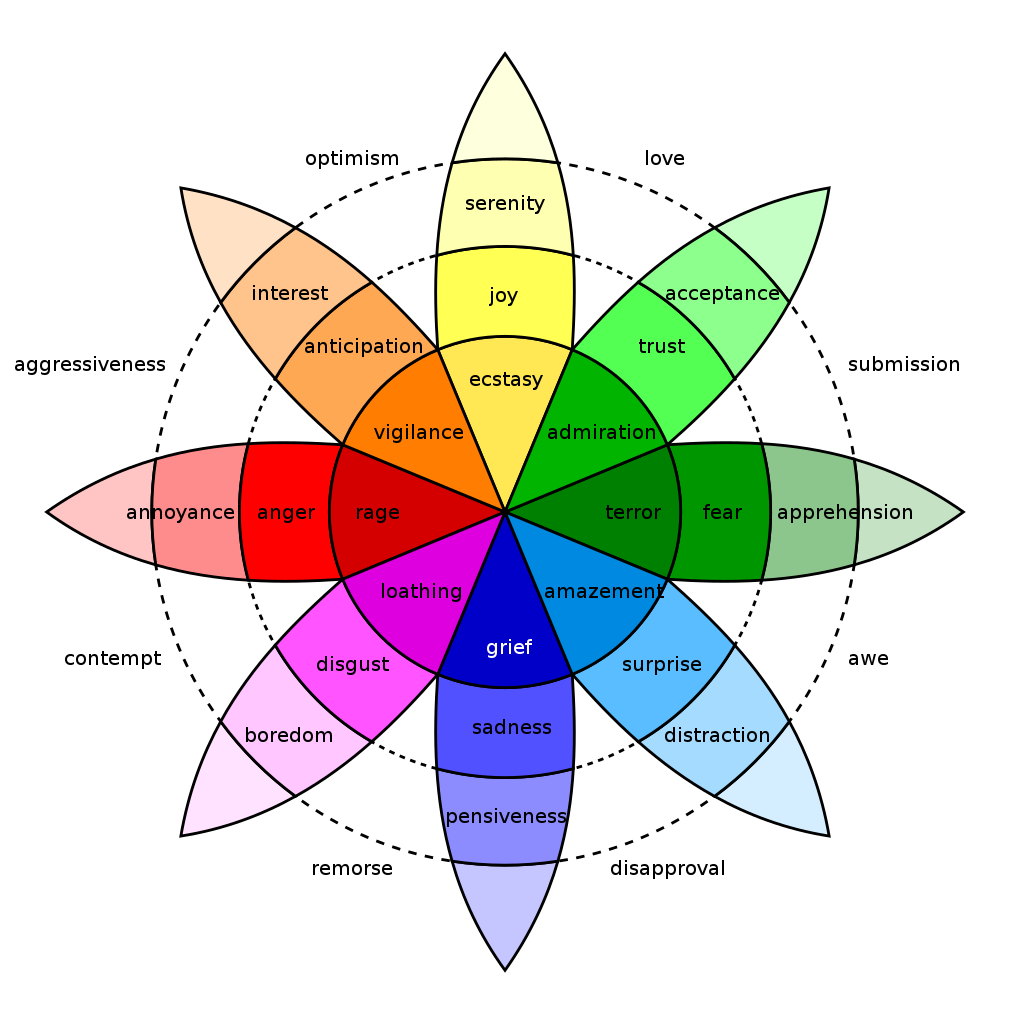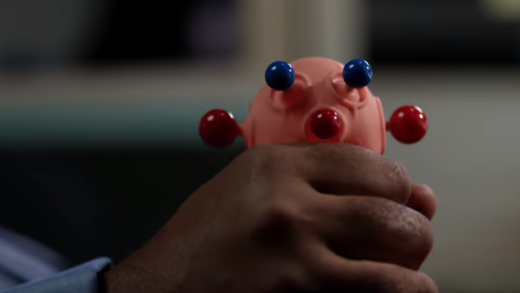Content is king.
-Bill Gates
It should come as no surprise that content is key to growing a website. From a technical standpoint, having new content helps remind users and bots that you’re active. So even if you have a tree trimming business and don’t think Facebook is for you, it’s helpful from a bot and user perspective.
It’s also why, however vacuous the term “blog” may be, it’s essential to driving traffic and improving visibility for keyword phrases. The silver lining to having a blog called a “blog” is there’s usually an ounce of leniency from users, legal, and product. Now, that said…
Good content happens on-page and results in off-page gains.
If you write a good article, people should want to share it.
So how do you write shareable content?
Plutchik’s Wheel of Emotions

In general, emotions that sit on opposite corners of Plutchik’s wheel tend to illicit positive or negative responses to the same piece of news. Since I’m a movies guy, you can see this with casting. When there’s an announcement of a new movie (like The Hobbit), it generates anticipation. Generally, anticipation has a positive connotation — you’re looking forward to something. So, then when it’s announced that Owen Wilson will play Frodo, you get the opposite, negative emotion: surprise. It’s not what you wanted.
It shouldn’t come as a surprise that “emotion-driven” content tends to drive more clicks. It’s the “marketing” angle of the SEO discipline. Take two example article titles:
- Mayor seeks to increase MPAA rating for movies featuring “smoking”
- Mayor condemns “free speech” in movies
The first is a relatively dry headline while the second broadens the scope and should illicit an emotional response. That emotional response may be seeking “confirmation bias” or to rush to the mayor’s defense. Is it an overreaction? Let the user decide.
Briefly, a Word on Clickbait
To be clear, writing article headlines — writing whole articles — with an emotional response is not clickbait. Jon Stewart (of The Daily Show) put it best:
It’s like carnival barkers, and they all sit out there and go, “Come on in here and see a three-legged man!” So you walk in and it’s a guy with a crutch.
This was Stewart defending Buzzfeed back in 2014 because he didn’t feel their articles were clickbaiting. Their articles tended to be, “Here are 19 things you didn’t know you needed” and it’s not as though the listicle only mentions 12. You get what you were promised.
Creating an emotion-driven piece of content, is not the same as clickbait. Okay, back to the strategy.
The 4 Most Shared Emotions: Awe, Fear, Anger, Sadness
Shareable content tends to appeal to 1 of these 4 emotions — perhaps unsurprisingly the latter 3 sum up every news outlet.
- Happiness or awe
In 2010, the New York Times found the most shared articles were those that made people view the world from a different perspective; made the person feel small. - Fear
This is traditionally used with anti-smoking or anti-drinking campaigns or, in some cases, insurance. - Anger
This is most effective when paired with surprise or anticipation as it can lead to action or a sense of awe due to feeling something is unfair or someone has suffered an injustice. Imgur’s most shared images are captioned with negative headlines, but the image surprises. - Sadness
Sadness has the potential to go viral especially if it provides a strong call to action or ends on an inspiring note. (See MetLife Ad from 2015.)
So you have the emotions, you get the examples, what’s this look like in practice?
Let’s take a relatively dry concept like… tree trimming.
- Happiness or awe: Healthy trees can increase property value by 19%.
The reader wants an easy way to increase their property value, plant a tree, help the environment and seek tree trimming services to keep it maintained. - Fear: 6 trees in every neighborhood that are fatal to dogs.
Apparently, in enough quantity, some fruit trees are toxic to pets… so keep them trimmed! - Anger: If a tree falls on your roof, but no one is around to claim it, does insurance cover it?
It’s a little clunky with how its worded, but you get the idea. It’s not talking about fatal or toxic trees, it’s talking about a colossal inconvenience. Like waiting in traffic. Adding a slight cheekiness can also help ease the user. You’re not trying to generate anger at you (the company) but at the situation. - Sadness: By 2050, the Earth will have less than 1% forest cover.
This is sad and, if you think about it too long, not really relevant to tree trimming, but this can be an upper funnel type of content that nudges people in the direction of thinking about planting trees in their yard to do their part.
It’s not that you need content for each emotion, but categorizing your content and playing with the different emotions can help cater your articles to your audience. It requires patience and testing.
And for the record, it takes tact. Companies shouldn’t be afraid to piss someone off, but I’d be wary of anyone that just throws an edgy title into an article. It’s the difference between:
- James Bond needs a sex change
and - 8 reasons why James Bond is all about female empowerment
The former isn’t just edgy, it’s tone deaf to a group of people being harassed. The content itself might just be about how it’s time for a female bond, but a lazy, emotionally charged title is likely going to hurt business more than help. Meanwhile, the latter can illicit anger in some people, but it may also spark the elusively positive emotion “awe.” Half of James Bond’s character is being suave, charming, a flirt, and fashionably dressed. And I don’t mean that that has to be a masculine or feminine trait, it can obviously be shared.




Thank you, understanding your audience’s psyche can elevate your content strategy. What psychological principles do you apply when crafting your content?
Hey! Thank you for reading!
I’m a big fan of any kind of subversion cus I like humor. In a speech class, someone wrote about how comedy is fundamentally presenting a question for the listener to answer, but then you provide the answer and it wasn’t what they were expecting but — especially in the case of puns — they appreciate it.
I think I have a post on here that’s SEO is Dead and we killed it. The post isn’t how that I think SEO is dead, but that’s the conversation in the ether.
Content is indeed king, and its importance cannot be overstated. Fresh content keeps both users and bots engaged, which is crucial for website growth. Even businesses like tree trimming can benefit from maintaining an active presence online. Leveraging emotion-driven content can significantly boost clicks and visibility. What strategies do you use to ensure your content resonates with your audience? Recently, I came across a program for GPT-generated text (генерация текста) in Russian. The cool part is that it runs locally on your own computer, and the output is actually unique and quite decent. By the way, I hope the content on your site isn’t AI-generated?
It’s not, but I’m not opposed to it in principle. I have a lot of “drafts” of posts because I’ll start on one thing and digress to something wholly different. I would definitely benefit from using AI to keep me on topic, but even the Gems I’ve made in Gemini haven’t quite figured it out yet even when I upload things I’ve written. I haven’t cracked it yet, but I’ll figure it out. Thank you for reading!